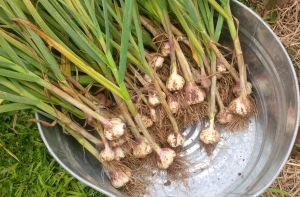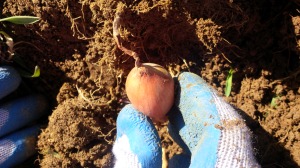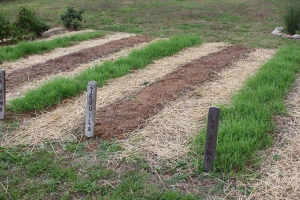It seems hard to believe, but the end of August is fast approaching! As our Summer garden and its wonderful bounty of fresh tomatoes, peppers, zucchini and more begin to wind down – its time to think about the Fall garden.
Although we will still get in a few more quick plantings of lettuce, kale, spinach and radishes – the end of summer signals to us that its time to get ready for our big “3” must-plant fall crops: Garlic, Onions – and the ultra-important cover crop of Annual Rye.
Garlic
Nothing beats the taste of home-grown garlic! It is one of the easiest crops to grow – and can be stored for year-round use in the kitchen.
Although garlic can be planted in the spring (especially soft-neck varieties in the warmer climates of the South) – the best time to plant hardneck garlic in the Midwest is in the fall.
Planting in the fall allows the garlic bulbs to get off to a good start – and although they go dormant during the winter months – they spring back to life and make for a great harvest in late June to early July of the following year.
For us here in the Midwest and for most of the Northern states – the best time to plant garlic is in mid to late September or the first week of October.
You can click on our link below to find out the specifics of planting garlic – and we will also be adding a video tutorial on our YouTube Channel as well in the coming week.
See: How To Plant Garlic This Fall
Onions
Much like garlic – Fall planted onions will mature quickly next spring in time for a late June or early July harvest – and always seem to bring a much larger size of onion than our same-year planted crop.
Onions can be planted in the same time frame as your garlic – with the same soil preparation and spacing of the planting rows.
Heading into Winter – we cover both our onion and garlic crops in a healthy 2 to 3″ thick layer of straw or leaf mulch. It not only helps to prevent weeds in the rows – but provides them with a little protection from Winter’s constant thawing and freezing.
Cover Crops – Annual Rye
And that leads us to our most important Fall crop of all – the annual rye cover crop! Although our cover crops don’t necessarily provide food for us – they certainly feed our garden.
Cover crops are simple to plant, require zero maintenance – and add tremendous amounts of organic matter and nutrition back to your soil. They also protect the soil from losing valuable nutrients from the snow, ice, wind and rain through the harsh winter months.
By covering the soil with a thick blanket of a super-charged cover crop – it also significantly cuts down on the amount of weeds in next year’s garden by keeping blowing and drifting seeds from finding a home.
We like to plant our cover crops in mid to late fall – giving them enough time (a month or so) to germinate and fill in the planting rows of our garden with a thick patch of growth.
In the Spring – we turn the cover crops over and back into the soil – releasing all of their nutrients to the coming year’s crop.
So there you have it – our 3 “Must Plant” fall crops!
Happy Gardening – Jim and Mary
If you would like to receive our Sunday Updates each week – be sure to sign up to follow the blog via email in the right hand column, “like” us on Facebook, or follow us on Twitter.




